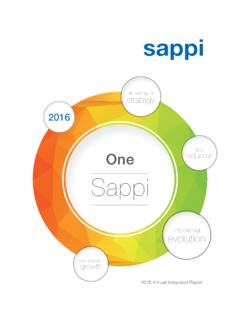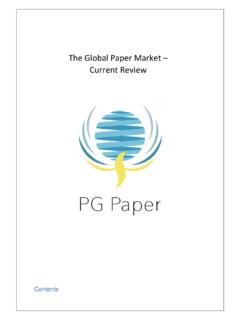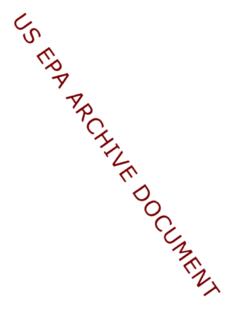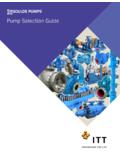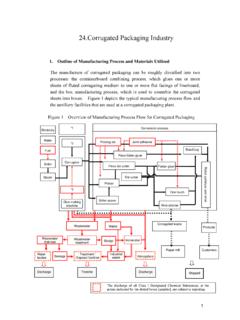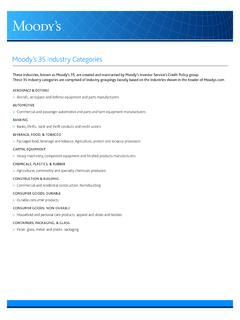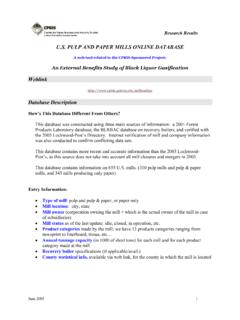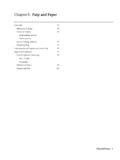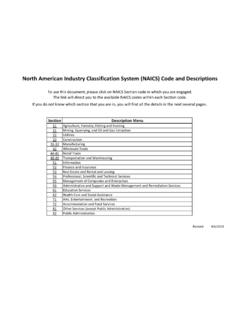Transcription of Understanding Paper Brightness - Sappi
1 Printer Technical Service Understanding Paper Brightness Introduction Brightness quantifies the percentage of blue light reflected from the surface of Paper as measured at a specific effective wavelength of 457 nanometers (with a 1. half-peak bandwidth of 44 nm). Brightness does not indicate the color or relative shade of the Paper since a single number reflective value measured at 457 nm ignores all other wavelengths of light reflected across the visible spectrum. A brighter Paper , therefore, reflects a greater amount of blue light than does the surface of a less bright Paper . Three different Brightness measurement methodologies are used worldwide. Each of these methods will produce a different Brightness number when used to measure the same Paper sample. It is, therefore, important to understand basic concepts of each of the three testing methods, including photometric principles, characteristics of the illuminants, and illumination/observer reflected light measurement geometries.
2 Due to differences in illuminants and illumination/reflected light measurement geometries, there are no direct correlations between Brightness measurements produced by the three methods. 1. Monitoring the photometric curve response throughout the pulp bleaching cycle shows that changes are greatest in the short wavelength area (the violet/blue region of the visible spectrum). Therefore, 457 nanometers has been determined to be an appropriate wavelength for optimal measurement of light reflection to monitor pulp and Paper Brightness . Sappi North America 1. 2017 Sappi North America. All Rights Reserved. Printer Technical Service The three Paper Brightness standards are briefly described as follows. TAPPI (T 452) / GE Brightness The Technical Association of the pulp and Paper industry (TAPPI) has authorized method T 452 for use in determining the Brightness of Paper .
3 TAPPI T 452. Brightness is often referred to as GE Brightness since General Electric invented one of the first Paper Brightness testing machines which became the industry standard for decades. The GE Brightness measurement scale has been in place since the 1930s. Considering there are two TAPPI standards for Brightness , we will hereafter refer to the T 452 method as GE Brightness . GE Brightness is used for specification of Paper Brightness primarily in North America. The International Commission on Illumination also known as the CIE from its French name, the Commission Internationale de l Eclairage, has defined the spectral power distributions of several illuminants which are divided into three categories: tungsten, daylight, and fluorescent. When measuring GE Brightness , the Paper sample is illuminated with a CIE.
4 2. illuminant C defined light source; a simulated daylight illuminant containing a 3. certain amount of energy. In-line Brightness filters are also applied which modify the spectral characteristics of the reflected illuminant. TAPPI T 452 specifies directional illumination/measurement geometry of 45 . illumination, 0 observation ( , 45 /0 ). In other words, the test instrument emits light which strikes the surface of the Paper at a 45 angle of incidence. A. photocell receptor is positioned at the N or 0 position, perpendicular to the Paper sample. The directional illumination/reflected light measurement geometry is illustrated in figure 1. 2. CIE illuminant C is no longer a CIE standard illuminant. However, the International Commission on Illumination publishes a spectral power distribution, tristimulus values, and chromaticity coordinates for illuminant C.
5 Illuminant C is used by many spectral and colorimetric measurement systems. 3. ISO 2470-2 states that the UV content of CIE illuminant C approximates levels of UV. energy present in certain indoor viewing conditions significantly less than the UV. content of CIE standard illuminant D65. Sappi North America 2. 2017 Sappi North America. All Rights Reserved. Printer Technical Service Photocell Detector Light Source 0 . 45 Brightness filters Paper Sample Directional Geometry (45/0 ). Figure 1. A focused beam of light strikes the Paper sample at 45 and, after passing through a series of filters, the reflected light is received by the photocell. The quantity of reflected light received by the photocell is measured and expressed based on a scale relative to the amount of light that would be reflected from a 100% reflective magnesium oxide standard.
6 Therefore, the expressed Brightness measurement mandated by the GE methodology is not an exact percentage of light actually reflected from the Paper . There are advantages and disadvantages to the directional geometry method 4. specified by the TAPPI T 452/GE Brightness standard. One of the challenges of directional illumination and measurement is that the focused illumination geometry makes the system sensitive to non-uniformities in the Paper . Different test results may be obtained when measuring in the machine and cross-machine directions ( , parallel to Paper grain and across Paper grain direction respectively). The industry typically measures the directional Brightness of Paper samples with orientation parallel to grain direction. 4. Technidyne Corporation Technical Bulletin No: 101: Diffuse vs.
7 Directional Brightness Measurement, provides an excellent overview of the advantages and disadvantages associated with the directional and diffuse measurement systems. Sappi North America 3. 2017 Sappi North America. All Rights Reserved. Printer Technical Service ISO Brightness (ISO 2470-1). The ISO Paper Brightness measurement system, as defined by ISO 2470-1 and TAPPI T 525, is used for specification of Paper Brightness throughout Europe and in many other parts of the world. When measuring ISO Brightness , the Paper sample is illuminated with a CIE. illuminant C light source; a daylight illuminant containing a certain amount of energy. This is the same illuminant used by the TAPPI T452/GE Paper Brightness measurement system (see footnotes 2 and 3). ISO 2470-1 specifies an illumination/reflected light measurement system which utilizes diffuse optical geometry (diffuse illumination, 0 observation; , d/0 ).
8 The instrument used to measure ISO Brightness illuminates the samples with light projected by two lamps into an integrating sphere. The interior wall of the sphere is coated with a highly reflective non-glossy material which allows the light to inter-reflect and illuminates the Paper sample from all directions; , diffusely. Photocells or diode receptors are positioned at the 0 position, perpendicular to the plane of the Paper sample, and record the amount of light reflected from the Paper 's surface. The computer analyzes the spectral power distribution of the reflected light and quantifies the energy response at 457 nanometers. Figure 2. illustrates the diffuse illumination/observation system. Diffuse measurement geometry integrates the light reflected across non- uniformities of the sample and averages the effects of reflective differences due to Paper directionality.
9 Therefore, ISO Brightness measurements are less sensitive to Paper surface and directional orientation irregularities. Unlike the TAPPI T 452/GE method, the ISO Brightness measurement system quantifies the actual percentage of light reflected from the sample at 457 nm rather than relating measurements to a scale correlated to the percentage of light reflected by an external standard. The ISO Brightness methodology typically produces a higher Brightness number than the TAPPI T 452/GE method when measuring the same Paper sample due to slightly greater fluorescence stimulation, the illumination/light measurement geometry, and the Brightness scales used. Sappi North America 4. 2017 Sappi North America. All Rights Reserved. Printer Technical Service Photocell Detector Integrating Gloss Trap Sphere 0.
10 Light Source Light Source Paper Sample Diffuse Geometry (d/0 ). Figure 2. D65 Brightness (ISO 2470-2). The D65 Brightness measurement system (ISO 2470-2) is essentially the same as the previously described ISO system (ISO 2470-1) with the exception of the specified illuminant. D65 Brightness uses the CIE standard illuminant D65, an outdoor (average north sky) daylight illuminant containing a significantly greater amount of UV energy than CIE illuminant C (as specified for ISO Brightness measurement). Therefore, the additional UV energy emitted by the D65 standard illuminant will produce a greater fluorescence response when the Paper contains optical brightening agents. Consequently, D65 Brightness measurements will be significantly higher (when Paper contains optical brightening agents) than those produced by the TAPPI T 452/GE or the ISO Brightness methods which specify an illuminant with less UV content.


